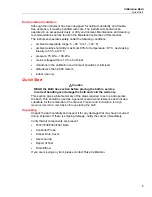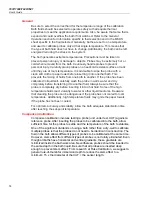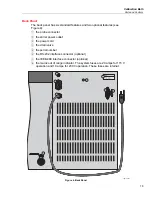
7037/7038/7040/7041
User's Guide
14
General
Be sure to select the correct fluid for the temperature range of the calibration.
Bath fluids should be selected to operate safely with adequate thermal
properties to meet the application requirements. Also, be aware that some fluids
expand and could overflow the bath if not watched. Refer to the
General
Operation
section for information specific to fluid selection and to the MSDS
sheet specific to the fluid selected. Generally, baths are set to one temperature
and used to calibrate probes only at that single temperature. This means that
the type of bath fluid does not have to change. Additionally, the bath can be left
energized reducing the stress on the system.
The bath generates extreme temperatures. Precautions must be taken to
prevent personal injury or damage to objects. Probes may be extremely hot or
cold when removed from the bath. Cautiously handle probes to prevent
personal injury. Carefully place probes on a heat/cold resistant surface or rack
until they are at room temperature. It is advisable to wipe the probe with a
clean soft cloth or paper towel before inserting it into another bath. This
prevents the mixing of fluids from one bath to another. If the probe has been
calibrated in liquid salt, carefully wash the probe in warm water and dry
completely before transferring it to another fluid. Always be sure that the
probe is completely dry before inserting it into a hot fluid. Some of the high
temperature fluids react violently to water or other liquid mediums. Be aware
that cleaning the probe can be dangerous if the probe has not cooled to room
temperature. Additionally, high temperature fluids may ignite the paper towels
if the probe has not been cooled.
For optimum accuracy and stability, allow the bath adequate stabilization time
after reaching the set-point temperature.
Comparison Calibration
Comparison calibration involves testing a probe (unit under test, UUT) against a
reference probe. After inserting the probes to be calibrated into the bath, allow
sufficient time for the probes to settle and the temperature of the bath to stabilize.
One of the significant dividends of using a bath rather than a dry-well to calibrate
multiple probes is that the probes do not need to be identical in construction. The
fluid in the bath allows different types of probes to be calibrated at the same time.
However, stem effect from different types of probes is not totally eliminated. Even
though all baths have horizontal and vertical gradients, these gradients are
minimized inside the bath work area. Nevertheless, probes should be inserted to
the same depth in the bath liquid. Be sure that all probes are inserted deep
enough to prevent stem effect. From research at Fluke Calibration, we suggest a
general rule-of-thumb for immersion depth to reduce the stem effect to a
minimum: 15 x the diameter of the UUT + the sensor length.
















































